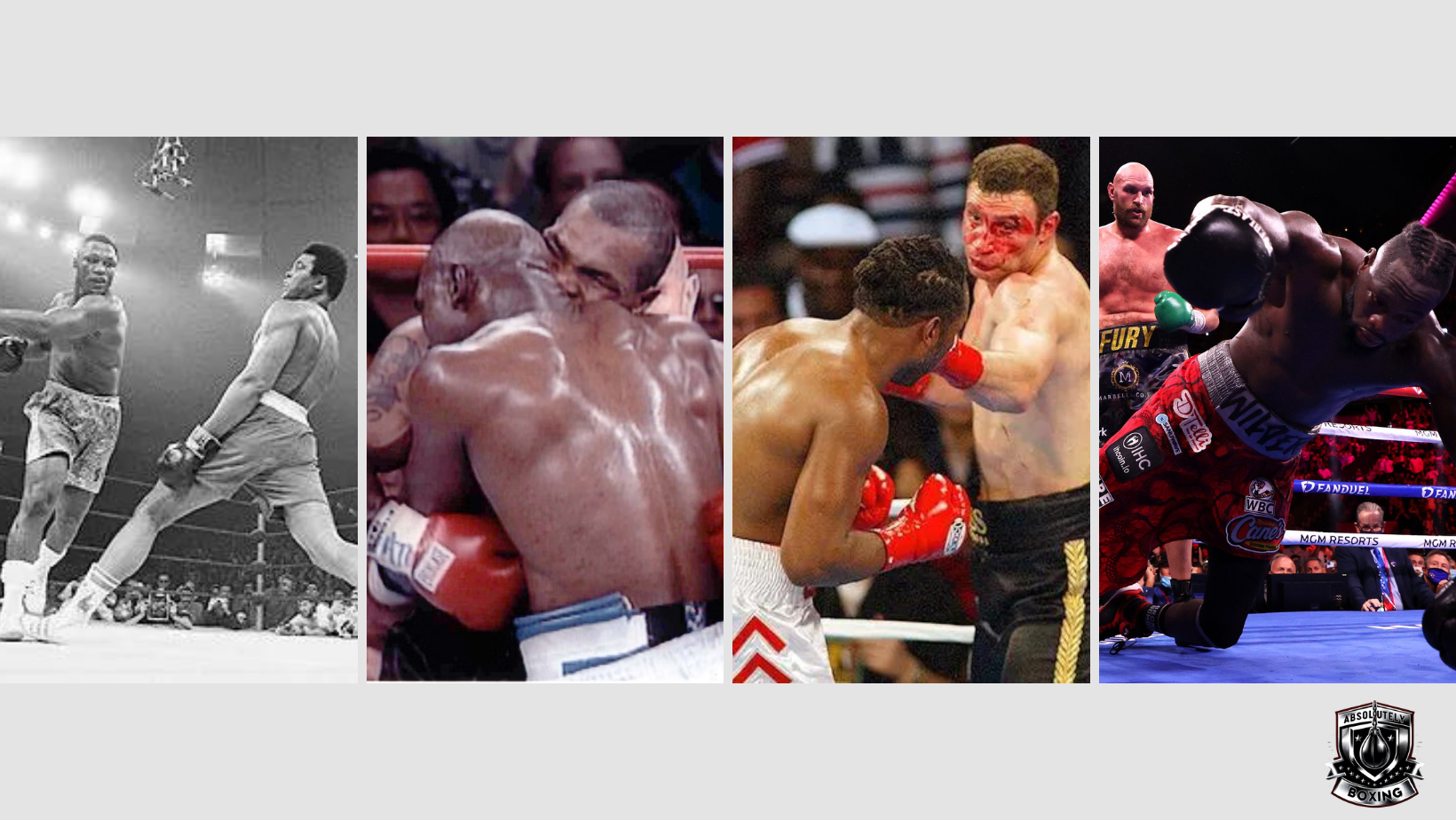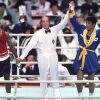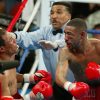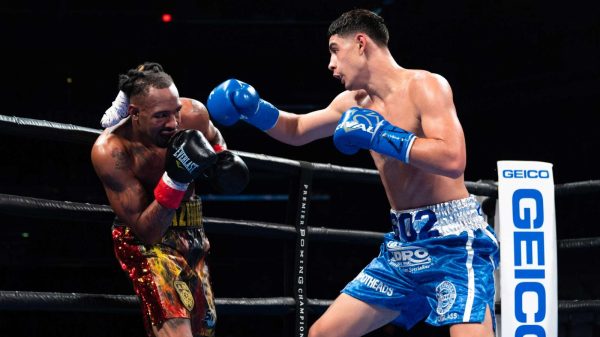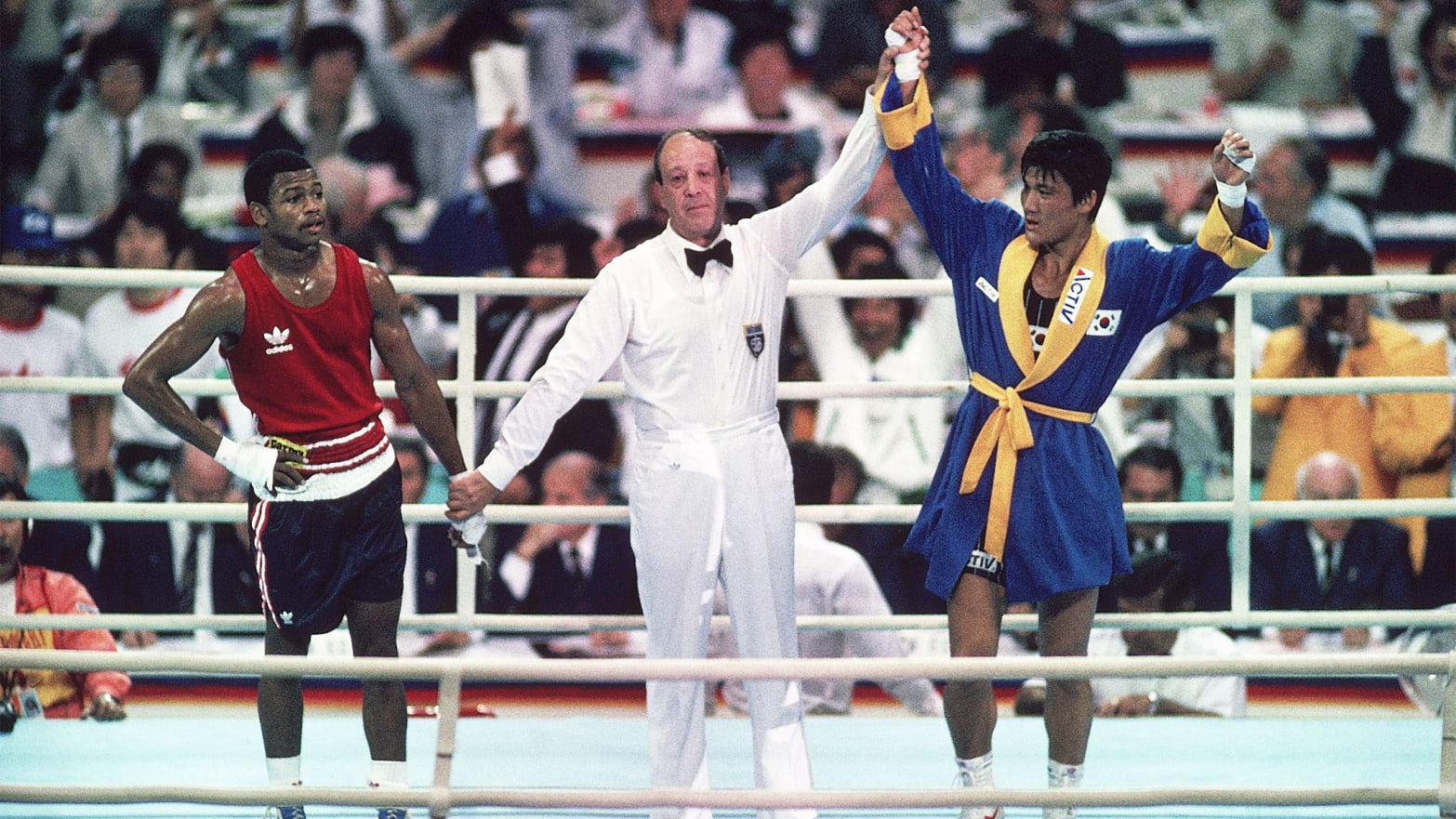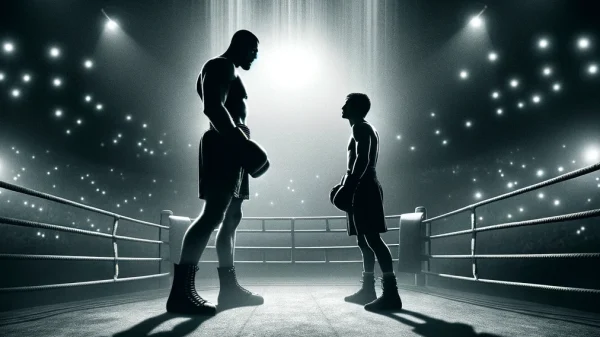The history of heavyweight boxing champions is filled with modern legends and tall tales. It all began in the gritty, bare-knuckle days of the 19th century, where figures like John L. Sullivan laid the groundwork for what would become the most illustrious division in boxing. Transitioning into the 20th century, the sport saw icons like Joe Louis and Rocky Marciano define an era with their unparalleled skill and valor. The narrative took a dramatic turn with the advent of Muhammad Ali in the 1960s, a boxer who transcended the sport with his charisma, prowess, and social activism, making heavyweight bouts a global spectacle. The baton was then passed to the likes of Mike Tyson in the 1980s, whose ferocity and speed redefined what it meant to be a heavyweight. Today, the legacy continues with stars like Tyson Fury and Anthony Joshua, who carry the division’s rich history into the modern era. Each era brought its own flavor, challenges, and icons, weaving a tapestry of tales that resonate with themes of resilience, triumph, and the eternal quest for greatness that defines heavyweight boxing.
This article aims to illuminate the heavyweight boxing title history, delving into the chronicles that have shaped this prestigious accolade. From the early days of bare-knuckle brawls to the sophisticated duels of today, we trace the evolution of the heavyweight division, exploring the lineage and the battles that have defined its glory. This journey through the history of heavyweight boxing champions is not merely a recount of victories but a tribute to the enduring spirit and resilience that these titans of the ring have showcased.
Moreover, the narrative pays homage to the best heavyweight boxers of all time, figures who have transcended the confines of the sport to become icons of courage, skill, and indomitable will. Through examining the careers and legacies of these legendary athletes, we gain insight into what makes a true champion. This exploration also ventures into the realm of controversy by inviting readers to debate the merits and achievements of these greats, igniting discussions on who truly deserves the title of “the greatest.”
By intertwining the heavyweight boxing title history with the personal sagas of the history of heavyweight boxing champions, this piece aims to offer a comprehensive and engaging perspective on the division. It’s a celebration of the best heavyweight boxers of all time and a reflection on the rich tapestry of stories that make heavyweight boxing a compelling saga of human endeavor and excellence.
The Beginnings
The heavyweight division, often hailed as the pinnacle of boxing, has a storied past that traces back to the late 19th century. This era, marked by raw encounters and bare-knuckle brawls, laid the foundation for what would become the most revered weight class in the sport. The inception of this division is intertwined with the evolution of boxing rules, transitioning from the laissez-faire London Prize Ring rules to the more structured Marquess of Queensberry rules, which introduced gloves and timed rounds, significantly altering the dynamics of the sport.
John L. Sullivan, known as the “Boston Strong Boy,” is often celebrated as the first heavyweight champion under these new regulations. Sullivan’s reign, which spanned from 1882 to 1892, was characterized by his formidable prowess and an indomitable spirit that epitomized the essence of early heavyweight boxing. His infamous claim of being willing to fight anyone under the Queensberry Rules for $10,000 underscored the bravado and the competitive spirit that would become synonymous with heavyweight champions.
The early 20th century saw the rise of iconic figures such as Jack Johnson, the first African American heavyweight champion, whose reign from 1908 to 1915 broke racial barriers and paved the way for future generations of boxers. Johnson’s dominance in the ring and his defiance outside of it, amidst intense racial prejudice, marked a significant chapter in heavyweight history, intertwining the sport with broader social and cultural narratives.
Following Johnson, the legendary “Manassa Mauler,” Jack Dempsey, took center stage in the 1920s, bringing unprecedented popularity to the heavyweight division with his aggressive style and knockout power. Dempsey’s battles, particularly his iconic matches against Gene Tunney, transcended the sport, turning boxing matches into major social events and elevating the status of the heavyweight champion to that of a national celebrity.
The era of Joe Louis, spanning from 1937 to 1949, further solidified the heavyweight division’s place in the annals of sports history. Known as the “Brown Bomber,” Louis’ reign is noted for its longevity and his role as a unifying figure during a time of racial tension and global conflict. His knockout victory over German fighter Max Schmeling in 1938, in the lead-up to World War II, was laden with political symbolism, illustrating how heavyweight boxing could reflect and influence societal moods and politics.
An Evolving Landscape Post War
The subsequent decades continued to build on the rich legacy of the heavyweight division, with each champion adding a new layer to its evolving story. The transformation of the sport was not just in the physicality and technique of the boxers but also in the way these athletes captured the public’s imagination, becoming symbols of strength, resilience, and, at times, resistance. The heavyweight division’s early days, marked by raw power and primal combat, gradually gave way to a more strategic and technically sophisticated form of boxing, reflecting the sport’s adaptation to changing times and audiences.
As the 20th century progressed, the heavyweight division witnessed the rise of figures who would further redefine the sport, setting the stage for the global spectacle that heavyweight boxing would become. The early history of the heavyweight division is not just a tale of individual champions but a saga of boxing’s evolution from backroom brawls to a respected and regulated sport, echoing the changing tides of history itself.
Floyd Patterson Rises and Gives Way to Sonny Liston
The transition from the era of Floyd Patterson to that of Sonny Liston marked a transformative period in the heavyweight division, characterized by a shift in both the style and public perception of heavyweight champions. Patterson, who became the youngest heavyweight champion in history in 1956 at the age of 21, was known for his speed, agility, and technical prowess. His reign brought a level of finesse to the heavyweight division, contrasting sharply with the brute force that had defined earlier champions. Patterson’s gentlemanly demeanor and sportsmanlike conduct both inside and outside the ring endeared him to the public and the media, setting a new standard for how heavyweight champions were viewed.
However, Patterson’s reign faced a formidable challenge in the form of Sonny Liston, a figure whose background and boxing style could not have been more different. Liston, with his intimidating presence and powerful punches, represented a throwback to the raw power of the division’s early days. His rise to prominence in the early 1960s, culminating in a devastating first-round knockout of Patterson in 1962 to claim the heavyweight title, signaled a dramatic shift in the archetype of a heavyweight champion.
Liston’s dominance in the ring was overshadowed by his troubled past and connections to organized crime, which cast a shadow over his championship reign. The public and media’s unease with Liston’s background, combined with his seemingly invincible presence in the ring, created a controversial and complex figure in the sport’s history.
The Greatest Emerges on the Scene
The Ali-Liston rivalry stands out as a defining moment in the annals of heavyweight boxing, presenting a vivid contrast between two distinct champions. When Cassius Clay, who would later be known globally as Muhammad Ali, stepped into the ring to face Sonny Liston in 1964, the odds were heavily stacked against him. Liston, with his daunting presence and track record of dominance, was anticipated to maintain his reign with ease. However, the fight unfolded in an unexpected manner, showcasing Ali’s unparalleled speed, agility, and strategic brilliance.
In their first encounter in Miami Beach, Ali’s strategy to “float like a butterfly, sting like a bee” left Liston bewildered, unable to match Ali’s footwork and quick jabs. The bout took a dramatic turn when Liston, citing a shoulder injury, failed to emerge for the seventh round, handing victory and the heavyweight title to Ali in a stunning upset. This victory not only shattered the invincibility surrounding Liston but also catapulted Ali to the forefront of the boxing world.
Their subsequent rematch in Lewiston further intensified the rivalry, ending in controversy with Ali’s “phantom punch,” which sent Liston to the canvas in the first round. The debate over the legitimacy of the punch added layers of intrigue and speculation to Ali’s triumph, cementing this rivalry in the collective memory of boxing fans.
This chapter in heavyweight boxing transcended the sport, reflecting broader societal changes. Ali’s rise mirrored the civil rights movement’s momentum, and his outspoken nature and political stances resonated far beyond the boxing ring. In contrast, Liston’s background and public persona embodied the sport’s grittier, more enigmatic aspects. The Ali-Liston clashes thus symbolized more than just athletic competition; they encapsulated a period of significant cultural and social upheaval, heralding a new era where the personalities and convictions of boxers became integral to their legacy in the sport.
Rivals to the Throne
Following the tumultuous Ali-Liston saga, the heavyweight scene transitioned into the iconic trinity of Muhammad Ali, George Foreman, and Joe Frazier. These three titans dominated the division, their rivalries becoming the stuff of legend. Ali, having dethroned Liston, found worthy adversaries in Frazier and Foreman, setting the stage for some of the most memorable bouts in boxing history.
Ali’s rivalry with Joe Frazier was marked by a trilogy of fights, each steeped in intensity and historical significance. Their first encounter, dubbed “The Fight of the Century” in 1971, saw Frazier handing Ali his first professional loss in a battle that lived up to its monumental billing. The brutal contest showcased the contrasting styles and sheer determination of both fighters, with Frazier’s relentless pressure and powerful left hook clashing against Ali’s speed and tactical genius.
The rivalry reached its zenith in the third and final match, the “Thrilla in Manila” in 1975, a bout so grueling that it transcended the sport itself. Fought under the sweltering Philippine heat, both warriors pushed each other to their limits, with Ali ultimately emerging victorious after Frazier’s corner halted the fight, marking the end of one of boxing’s greatest trilogies.
In between these epic battles with Frazier, Ali faced George Foreman in 1974 in “The Rumble in the Jungle,” held in Zaire. Foreman, known for his devastating power, was heavily favored, but Ali stunned the world with his “rope-a-dope” strategy. By absorbing punishment while leaning on the ropes and conserving energy, Ali goaded Foreman into exhausting himself, setting up an eighth-round knockout that reclaimed the heavyweight title for Ali.
These encounters among Ali, Frazier, and Foreman not only defined an era in heavyweight boxing but also embodied the sport’s dramatic appeal, showcasing the blend of physical prowess, mental fortitude, and strategic acumen that makes boxing a captivating spectacle.
The Lost Generation Rises
As the golden era of Ali, Frazier, and Foreman waned, heavyweight boxing entered a period often referred to as the “lost generation.” This transition phase was characterized by a vacuum of charismatic superstars who could fill the immense shoes left by their predecessors. While the previous icons had captivated the world with their larger-than-life personalities and historic battles, the new crop of heavyweights struggled to forge a similar connection with the global audience.
This era saw a multitude of champions, each with commendable skill and prowess, yet none managed to dominate the division or capture the public’s imagination in the way Ali, Frazier, or Foreman had. Fighters like Larry Holmes and Michael Spinks did achieve significant success and recognition during this time. Holmes, with his formidable jab and longevity, managed to defend his title successfully multiple times, carving out a respectable legacy despite the constant comparisons to those who came before him.
Similarly, Michael Spinks, transitioning from light heavyweight to heavyweight, made his mark by defeating Larry Holmes. However, their reigns lacked the dramatic narrative arcs and the intense rivalries that had defined the previous era. The boxing community yearned for bouts that echoed the epic confrontations of the ’70s, but such matchups were few and far between.
This period of transition was not without its merits, as it showcased the depth and diversity of talent within the heavyweight division. Yet, the absence of a singular, unifying figure or rivalry led many to view this time as a lull between the storied past of heavyweight boxing and the anticipation of a new era that would hopefully rekindle the sport’s former glory. The “lost generation” thus represents a complex chapter in boxing history, marked by both the challenge of living up to an unparalleled legacy and the relentless pursuit of greatness in the shadow of giants.
Mike Tyson Puts the Division on Notice
Mike Tyson’s ascent in the late 1980s revitalized the heavyweight division, offering a narrative of dominance and invincibility that captivated the world. Tyson’s blend of blistering speed, formidable power, and an aggressive fighting style led to a rapid succession of victories, many by knockout, solidifying his reputation as “The Baddest Man on the Planet.” His climb to the top was meteoric, becoming the youngest heavyweight champion in history and unifying the belts, which underscored the resurgence of interest in heavyweight boxing.
However, Tyson’s seemingly unstoppable rise was dramatically halted in 1990 by James “Buster” Douglas in Tokyo, Japan. In what is considered one of the biggest upsets in sports history, Douglas, a 42-to-1 underdog, knocked out Tyson in the 10th round, stripping him of his aura of invincibility and his heavyweight titles. This loss was not just a pivotal moment in Tyson’s career but also a stark reminder of the unpredictability inherent in the sport of boxing.
Compounding his challenges within the ring, Tyson’s life outside of it was marked by legal issues and personal turmoil, which often overshadowed his athletic achievements. His struggles with the law, including a conviction for rape in 1992, led to a prison sentence that temporarily derailed his boxing career. These off-ring battles painted a complex picture of Tyson, intertwining his pugilistic prowess with a tumultuous personal life, and adding a layer of depth to his legacy that went beyond his contributions to the sport.
Despite these challenges, Tyson’s impact on the heavyweight division remains indelible. His early career dominance, shocking defeat to Douglas, and the controversies that followed, together weave a narrative that is as compelling as it is turbulent, reflecting both the highs and lows of a career that forever changed the landscape of heavyweight boxing.
The Interregnum Period
In the wake of Mike Tyson’s reign, the heavyweight division witnessed the rise of a new cadre of champions, among them Lennox Lewis, who epitomized the era’s skill and strategic depth. Lewis, with his imposing stature and cerebral approach to boxing, emerged as a dominant force, crafting a legacy through notable victories and unification bouts that underscored his technical mastery and ring IQ.
A pivotal moment that underscored this new era was George Foreman’s stunning knockout of Michael Moorer in 1994. At 45, Foreman reclaimed the heavyweight title, becoming the oldest world heavyweight champion in history. This victory was more than just a remarkable personal achievement for Foreman; it served as a bridge between eras, connecting the golden age of the 70s with the evolving landscape of the 90s. Foreman’s triumph over Moorer was a testament to the timeless nature of power and experience in the heavyweight division.
The era also saw its share of unexpected developments, such as Hasim Rahman’s shocking knockout of Lennox Lewis in 2001. Rahman’s victory was a reminder of the heavyweight division’s unpredictability, where a single punch could alter the course of history. Although Lewis would later avenge his loss and solidify his status as one of the era’s premier fighters, Rahman’s win added an element of drama and intrigue to the division’s narrative.
This period in heavyweight boxing was marked by a blend of technical refinement and the enduring allure of the knockout, with fighters like Lewis leading the way with their strategic acumen, while moments like Foreman’s victory and Rahman’s upset reminded fans of the sport’s inherent unpredictability and excitement. The post-Tyson era, punctuated by these highlights, showcased the division’s evolving dynamics and the emergence of new legends who would carry the legacy of heavyweight boxing into the new millennium.
The Klitschko Brothers Take Control of the Division
The rise of Vitali Klitschko in the early 2000s marked a significant shift in the heavyweight division, heralding the arrival of a new era dominated by Eastern European fighters. Klitschko, hailing from Ukraine, brought a unique combination of size, skill, and intellectual approach to the sport, distinguishing himself from his predecessors. Standing at 6’7″ with a PhD, Klitschko was dubbed “Dr. Ironfist” for his formidable knockout power and analytical approach to boxing.
Vitali’s ascent was characterized by his remarkable resilience and tactical acumen. Despite a setback in a highly competitive bout against Lennox Lewis in 2003, where a severe cut led to a TKO loss, Klitschko’s stock rose in defeat. His performance against Lewis, where he was ahead on the scorecards before the stoppage, showcased his ability to compete at the highest level, earning him respect within the boxing community and among fans.
Following his recovery, Klitschko’s dominance in the heavyweight division became more pronounced. He captured the WBC heavyweight title in 2004, and his reign was marked by a series of successful defenses. Klitschko’s fighting style, characterized by a strong jab, precise straight right, and exceptional ring IQ, allowed him to control bouts and neutralize his opponents’ strengths effectively.
Wladamir Klitchko Joins his Brother
In the shadow of Vitali Klitschko’s towering presence within the heavyweight division emerged his younger brother, Wladimir Klitschko, who would go on to carve out a legacy arguably surpassing that of his elder sibling. While Vitali set the stage with his resilience and strategic prowess, Wladimir, known as “Dr. Steelhammer,” extended the Klitschko dominance with a blend of technical skill, formidable power, and a reign that would etch his name deeply into the annals of boxing history.
Wladimir’s rise wasn’t without its early setbacks, facing knockouts that raised questions about his resilience. However, under the guidance of legendary trainer Emanuel Steward, Klitschko underwent a transformation that saw him refine his technique and adopt a more cautious approach. This tactical shift, coupled with his powerful jab and devastating right hand, paved the way for a dominant streak in the heavyweight division. Wladimir’s reign as champion was marked by a methodical dismantling of challengers, amassing a string of title defenses that highlighted his superior skill set and strategic mind.
The Klitschko era, particularly under Wladimir’s reign, was characterized by a certain predictability and control that stood in contrast to the more volatile periods that preceded it. His ability to dictate the pace and tone of his fights, maintaining distance and leveraging his reach advantage, made him a formidable champion who redefined what it meant to be a heavyweight boxer in the modern era.
However, the narrative of invincibility surrounding Wladimir Klitschko was dramatically altered in 2015 when he faced Tyson Fury. In a surprising turn of events, Fury’s unconventional style, mobility, and psychological warfare inside and outside the ring unsettled Klitschko. The unanimous decision victory for Fury ended Wladimir’s decade-long reign, serving as a stark reminder of the unpredictable nature of boxing and marking the end of an era dominated by the Klitschko brothers. This loss to Fury not only highlighted the ever-present potential for upset in the sport but also underscored the legacy of the Klitschko era, characterized by dominance, technical brilliance, and a profound impact on the heavyweight division.
Tyson Fury, The Latest in a Long Line of Heavyweight Greats
Tyson Fury’s ascent within the heavyweight division is a narrative rich with comebacks, controversy, and unconventional charisma that have made him a standout figure in modern boxing. Dubbed “The Gypsy King” for his Irish Traveller heritage, Fury’s career trajectory has been anything but linear, marked by significant challenges both inside and outside the ring.
Fury’s rise was steady, showcasing his unique blend of size, agility, and boxing IQ, which is uncommon for a fighter standing at 6’9″. His ability to combine the finesse of a much smaller man with the power expected of a heavyweight quickly distinguished him in a division craving charismatic and skilled champions. Fury’s early career was characterized by a series of victories that showcased not only his technical skill but also his ability to entertain and engage with the audience, bringing a new level of excitement to the heavyweight category.
The pinnacle of this phase in Fury’s career came in November 2015, when he faced Wladimir Klitschko. Entering the bout as an underdog, Fury employed an unorthodox strategy that bewildered Klitschko, using his movement, reach, and psychological tactics to secure a unanimous decision victory. This win not only earned him the WBA (Super), IBF, WBO, IBO, Ring magazine, and lineal heavyweight titles but also ended Klitschko’s long-standing reign, signaling the arrival of a new force in the division.
However, Fury’s triumph was soon overshadowed by struggles outside the ring, including issues with substance abuse, mental health challenges, and legal battles over doping allegations. These struggles led to a hiatus from boxing, putting his career in jeopardy and casting doubt on his return to the sport.
Fury’s journey up until the brink of his comeback is a testament to the trials and tribulations that often accompany great talent. His early career and victory over Klitschko highlight the potential for greatness, while his subsequent battles underscore the human element of the sport, reminding fans that even the mightiest champions face their own set of challenges.
The 21st Century Triumvirate
The heavyweight division witnessed a riveting drama unfold with the rivalry among Tyson Fury, Deontay Wilder, and Anthony Joshua, each bringing their own style, charisma, and storyline to the forefront. This triumvirate rekindled global interest in heavyweight boxing, creating a web of potential matchups that fans eagerly anticipated. However, the failure to materialize a fight between Deontay Wilder and Anthony Joshua, despite intense speculation and demand, left fans yearning for what could have been a defining bout for the era. Negotiations faltered amid disputes over terms, leaving a gap in the narrative that many hoped would crown an undisputed heavyweight champion.
Amidst these negotiations, Anthony Joshua faced an unexpected setback against Andy Ruiz Jr. in June 2019. Entering the fight as a significant favorite, Joshua’s loss by TKO was a shock to the boxing world, reminiscent of the sport’s unpredictable nature. This upset not only derailed plans for a Joshua-Wilder showdown but also reshuffled the division’s hierarchy, highlighting the ever-present possibility of surprise in boxing.
The saga took another compelling turn with the Tyson Fury and Deontay Wilder trilogy, a series of fights that captivated audiences worldwide. Their first bout in December 2018 ended in a controversial split draw, with Fury miraculously rising from a brutal knockdown in the 12th round, showcasing his resilience and indomitable spirit. The rematch in February 2020 saw Fury dominate Wilder, employing a more aggressive approach to secure a seventh-round TKO, reclaiming the WBC heavyweight title and solidifying his comeback.
The trilogy concluded with an epic third fight in October 2021, where Fury overcame Wilder in a thrilling contest that saw both fighters hit the canvas. Fury’s victory in the trilogy’s finale further cemented his status as a premier heavyweight and added another chapter to the storied rivalry among these three titans of boxing. The Fury-Wilder-Joshua triangle, with its blend of missed opportunities, unexpected upsets, and legendary trilogies, has defined a vibrant era in heavyweight boxing, replete with drama, excitement, and the unpredictability that makes the sport truly captivating.
The Current State of the Heavyweight division
Emerging from the exhilarating era defined by Tyson Fury, the heavyweight division now stands on the cusp of a new chapter, with Oleksandr Usyk’s ascendancy as a pivotal storyline. Usyk, transitioning from an undisputed cruiserweight champion to a heavyweight contender, has quickly established himself as a formidable force. His technical prowess, exceptional footwork, and strategic acumen have translated effectively to the heavyweight ranks, culminating in his victory over Anthony Joshua to claim the WBA (Super), IBF, WBO, and IBO heavyweight titles. Usyk’s rise challenges the traditional heavyweight archetype, favoring skill and strategy over sheer size and power, and reshaping the landscape of the division.
Amidst Usyk’s ascension, the boxing community buzzes with anticipation over the potential showdown between Tyson Fury and Anthony Joshua. This British clash has been touted as one of the most significant heavyweight bouts in recent memory, promising to unify the titles and crown an undisputed champion. Negotiations and speculations have created a palpable tension, as fans and pundits eagerly await what could be a defining moment for the division.
Into the Future
Looking towards the horizon, the heavyweight division’s future seems to be in promising hands, with a new generation of fighters ready to forge their own legacies. Among the standout prospects is Jared Anderson, a boxer with a two-time national champion pedigree. His rise through the ranks has been marked by a series of emphatic victories. Anderson’s combination of power, agility, and boxing IQ makes him a name to watch, as he positions himself as a future contender for the heavyweight crown. His performances have not only captivated fans but have also drawn comparisons to some of the greats of the sport, underscoring his potential to be a central figure in the division’s next chapter.
Efe Ajagba, another rising star, brings devastating knockout power and an imposing physical presence to the ring. The Nigerian heavyweight has quickly built a reputation for his explosive finishes, capturing the attention of the boxing world. Ajagba’s raw talent, honed under the guidance of renowned trainers, suggests a bright future and the possibility of him becoming a key player in the heavyweight saga.
Beyond Anderson and Ajagba, the division is teeming with talent eager to make their mark. Fighters like Filip Hrgović, Daniel Dubois, and Tony Yoka come from diverse backgrounds, each bringing their unique strengths and stories to the heavyweight landscape. Their emergence signals a vibrant and competitive future, where new rivalries and iconic bouts await.
As the heavyweight division evolves, these young contenders represent the dawn of a new era, each aspiring to etch their name in the annals of boxing history. With the blend of skill, power, and ambition they bring, the future of the heavyweight division promises not just continuation of its storied legacy but an exciting expansion, full of potential classic matchups and unforgettable moments that will captivate the sporting world.


